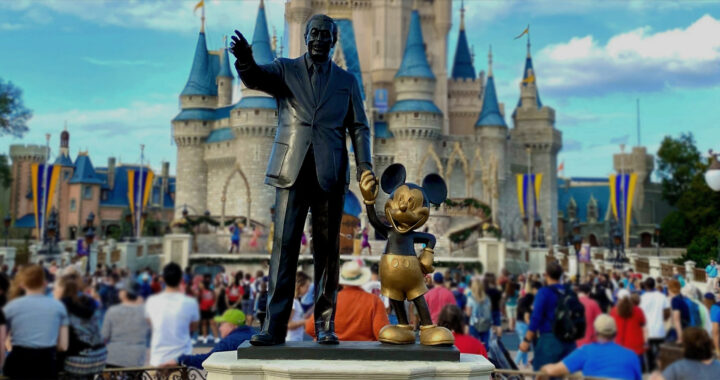The history of The Walt Disney Company does not only follow the stories of brothers Walter Elias Disney and Roy Oliver Disney. It is also part of the greater history of the film and television industry. The company started with the signing of a contract with M. J. Winkler to produce the animated series Alice Comedies on 16 October 1923. Brothers Walter and Roy subsequently founded The Disney Brothers Studies as a small independent animation studio. It then began producing more animated series for television and created characters that eventually became household names. The company expanded its business interest and soon became a global conglomerate.
A History of The Walt Disney Company: From Creating Mickey Mouse To A Diversified Media and Entertainment Conglomerate
1920s-1930s: Introducing Mickey Mouse
It is worth noting that the origin story of Mickey Mouse was intertwined with another cartoon character named Oswald The Rabbit. W. Disney created it for his first animation series in 1927 but he lost the rights to Oswald to his distributor. This setback led to the creation of the character Mortimer who was later renamed to Mickey Mouse.
Mickey Mouse has undeniably become one of the most endearing and greatest creations of the company. The first Mickey Mouse reel was created between February to March of 1928. The series was called Plane Crazy but its first two episodes were never shown before the public because W. Disney was unsuccessful in finding a distributor.
W. Disney pushed for another shot when he produced the third episode called Steamboat Willie. The episode premiered in Colony Theater in New York on 18 November 1928. Mickey Mouse received wide popularity even outside the United States, thus becoming a global phenomenon. W. Disney received an Academy Award for this breakthrough character in 1932.
Note that the popularity of Mickey Mouse was not limited to the big screen. The character began appearing in comic strips in 1930. This was followed by merchandising, theme parks, and countless other ventures and licensing deals that solidified Mickey Mouse as a global icon. This character became the official mascot and corporate icon of the company.
1930s-1970s: Further Entertainment Ventures
Several milestones marked the early history of The Walt Disney Company. The first full-color cartoon produced by the company, Flowers and Trees, was released on 30 July 1932. It was also the first of its kind in the entire history of animation and film production. The company also introduced newer characters alongside Mickey Mouse to include Donald Duck.
W. Disney also ventured into animating folk tales from different literary sources. His studio also began producing socially relevant content and education shows for children. Snow White and the Seven Dwarves was released in film theaters on 21 December 1937. Take note that this was the first full-length animated film of the company.
The company was unstoppable. It diversified into other businesses. W. Disney designed a large-scale theme park in 1959 that was later opened in 1955 in Anaheim, California. He called it Disneyland. Another theme park was built in 1971 in Florida. It was named The Walt Disney World. The company also ventured into publishing and toy merchandise.
1970s-1990s: Consolidation and Internationalization
The various business activities and units of the company were consolidated under The Walt Disney Company in 1980. This marked a major turning point in the history of The Walt Disney Company because it paved the way for its future strategic direction that centered on expansion across different facets of media and entertainment.
It extended its business beyond American borders. The company entered and completed a series of acquisitions and expansions from the 1980s to 1990s. It opened Buena Vista Distribution, Disney Channel, and Touchstone Pictures during the 1980s, and it acquired independent film distributor Miramax and put up the book publishing arm Hyperion during the 1900s.
The company has become a global empire with strong business interests in various facets of mass media including television, film, publishing, and music beginning at the end of the 1990s. Some of its media outfits have enjoyed international exposure. Its film production and distribution arms alone have widespread global reach.
Furthermore, apart from its business interest in media, its parks and resorts, as well as consumer products are also operated, manufactured, or distributed in several parts of the globe. This diversification not only captured the global market but also expanded the operation of the company, thus turning it from an American company to a truly global conglomerate.
1990s-2000s: Renaissance and Further Expansion
The animation industry saw a decline in the 1980s but experienced a resurfacing in the 1990s after the 1989 showing of the animated film The Little Mermaid. The following years saw a series of more iconic animated films. These include Aladdin in 1992, The Lion King in 1994, Pocahontas in 1995, and The Hunchbacked of Notre Dame in 1996.
Several live-action films also became notable. These include Pretty Woman in 1990, The Mighty Ducks in 1992, and Armageddon in 1998. The company also pursued a series of acquisitions to expand its business and presence. Pixar was acquired in 2006 and Marvel Entertainment was acquired in 2009. Lucasfilm was also acquired in 2012.
The company also acquired Capital Cities in 1996 and the 21st Century Fox in 2019. These acquisitions gave it rights to own and produce several content and intellectual properties. These include the iconic Marvel Cinematic Universe and the Star Wars and Indiana Jones franchises. The video streaming service Disney+ was also launched in 2019.

